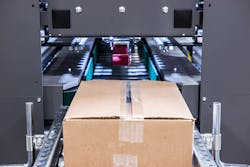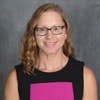The manufacturers and suppliers that support industrial automation industries are loosening their grip on hardware-dominated portfolios and embracing software and service subscription-based models. Others outside of industrial automation are also recognizing the potential for sweeping innovation.
Software-based business models are both leading the digital transformation of industry and pushing traditional automation companies to both specialize and diversify. Individual products are becoming more customized for specific customers, and companies are also branching into new arenas, as the industry becomes less dependent on hardware overall.
Also read: 4 trends driving industrial technology
Figure 2: Pearson Packaging uses blockchain technology to create a distributed ledger system that allows the company to charge customers a per-case rate.
More than 20 years ago, Pearson Packaging Systems, a machine builder for secondary packaging equipment, was one of the early adopters of Salesforce.com, a software subscription service for customer relationship management (CRM) technology. Early on, the company often asked Pearson Packaging to sit in on customer calls with Fortune 500 companies “to help sell them on the idea of software as a service,” says Mike Senske, president of Pearson Packaging. “It took years and years to get that widespread adoption.”
In 2019, Pearson Packaging launched its own machines-as-a-service business model. Armed with its experience with as-a-service models in its own business, Pearson Packaging saw potential for this business model in the packaging industry.
Senske first started thinking about the service model on a larger scale more than a decade ago. At the time, he had a few customers that didn’t have money in their budgets to purchase new equipment. Instead, they asked to rent used equipment from Pearson Packaging. Even when the company’s monthly rental fees had exceeded the cost of the equipment outright, they continued to rent the machines, rather than purchase them. They couldn’t get the capital-expenditure budget approved, but the monthly fee was granted out of the operating budget. Senske says often companies can set a certain internal rate of return on automation projects, and, if projects don’t meet that standard, no matter how close, they don’t get funded.
Figure 3: The contract outlines what is paid per successful case, erected, packed and sealed or palletized, depending on the customer needs.
“We were looking at that and saying there are a lot of customers who really have good business cases for automating certain processes in their end-of-line packaging, but, for whatever reason, they had finite access to capital,” Senske says. “And yet many of those projects would have been accretive to their bottom lines and accretive to their shareholders, if they automated them.”
Enter the machines-as-a-service model. “There’s an alternative approach,” Senske says. “It allows them to pay for the automation with savings that they otherwise wouldn’t have achieved in the absence of that automation, so it’s kind of a self-funding mechanism.”
Pearson Packaging focuses on end-of-line equipment in many industries, including food and beverage, personal care, chemical, online commerce and pharmaceutical industries. Food-and-beverage manufacturing makes up about 50% of the business, Senske says. “Once the product is in its primary package, we’re the last automation that helps get the product packaged safely into its final shipping container and then into the back of a truck,” he adds.
Figure 4: On a weekly basis, the system automatically drafts the needed payment from the customer's bank account, based on the number of completed cases.
While Pearson Packaging has never seen machines-as-a-service as a huge part of its business, it is committed to growing the as-a-service business incrementally. In its model, Pearson builds the piece of equipment and then delivers, installs and commissions the equipment, including training of any operations and maintenance personnel. Senske says most of its customers have expressed a strong preference for keeping maintenance activities in-house. “They have entire crews that are dedicated to doing that now in the old model,” Senske says.
Payment is not a monthly or flat fee system. Pearson Packaging uses blockchain technology, which Senske describes as “a distributed ledger system” that allows them to charge customers a per-case rate. The blockchain tech takes performance data from the equipment and puts it into a ledger, which cannot be manipulated by either Pearson Packaging or the customer.
The contract outlines what is paid per successful case, erected, packed and sealed or palletized, depending on the customer needs. “It’s safe; it’s secure; and it’s based on the data that’s coming directly from the machine,” Senske says. On a weekly basis, the system automatically drafts the needed payment from the customer’s bank account, based on the number of completed cases. It requires no invoicing from Pearson Packaging. The contract also includes spare parts, which are sent to customers based on performance and usage data without having to issue purchase orders.
This business model is not, however, for everyone, Senske says. The company does have pointed efforts to grow this part of the business and has developed a sales team that can educate customers about its benefits. Pearson Packaging does not offer its entire product line for machines-as-a-service, Senske says, and it’s not a fit for every customer.
Figure 5: Although each customer application is a little bit different, there's a lot of homogeneity in terms of products without much customization, such as palletizers.
“What we’re focusing on are the products that don’t have a tremendous amount of customization in terms of their core functionality,” Senske says, equipment like case erectors, case sealers or compact palletizers. “Even though each customer application is a little bit different, there’s a lot of homogeneity in terms of the machinery itself.”
The ideal customer profiles for Pearson Packaging are higher volume manufacturers, running multiple shifts per day and running five or more days a week in a very demanding production environment. “It’s not a methodology of getting people to automate that shouldn’t be automating, or that should be automating with a different kind of technology,” Senske says. “It’s not making a really expensive piece of equipment affordable to somebody who doesn’t need it.”
A limitation of the service for now is that the available equipment is a subset of what Pearson Packaging offers. “We hope, as time goes on, to figure out how to make it work and how to build a business case to include the entire product line, but we’re probably a couple of years from being at that point,” Senske says.
The process will require a lot of education with customers. “You're overcoming the new approach, at least on the industrial-equipment side of things. But generally, there's a lot of interest, and I think we're trying to educate people about the technology, about how it works, about the model itself, and then also making some tweaks as we go to make it a little bit more palatable for customers, as well,” Senske says.
This article is a part of a series about equipment-as-a-service. Explore more about this topic in the following articles.
- Machines-as-a-service bolster packaging industry
- Equipment-as-a-service: A CapEx vs OpEx decision
- Hands-off utilities guaranteed
- Equipment, production and machines at your service
Another area where Senske thinks the company can expand the business model is with predictive maintenance. Remote connectivity and data collection and analysis are intrinsic to how the service works, from sending spare parts to payment. Mostly, Pearson Packaging is using its data to monitor equipment usage and performance to ship spare parts, but it could expand its service doing more monitoring and predictive maintenance. In some cases, it does monitor data intermittently, and can alert customers to anomalies that might affect the efficiency rate of the machine, Senske says. The company knows its machines very well and knows optimal levels for their performance. While the company is not doing a lot of proactive maintenance engagement, Senske would like to build on that service. “Where I’d like us to be is where we can monitor mission-critical components on the machine,” Senske says. They can detect vibrations or temperatures that are out of normal operating ranges, which could cause a component failure before it occurs. Pearson Packaging is dabbling in this area for now. “And I think that’s only going to grow as time goes on and people continue to adopt that approach,” Senske says.
Pearson Packaging is not expecting customers across the board to adopt this as-a-service model, even down the line. But Senske predicts that, in five years, machines-as-a-service will represent 20 to 25% of the business. “The adoption of this has been slow and steady,” he adds.
Not only is the business model new to industry with its own learning curve, but the financial structure has also changed the sales process. When faced with approving an operating expense vs. capital expenditure, some customers don’t even know where to go in their organization for permission. Pearson Packaging has had to engage with customer personnel that it hadn’t traditionally in the sales process, and executive finance personnel need the same kind of education about how the model works.
The machines-as-a-service program at Pearson Packaging started not that long before COVID, and the pandemic has had both negative and positive impacts on the business, Senske says. The whole education process and working with new people in the organizations was hindered by the inability to be face-to-face in order to build trust and rapport. “That kind of slowed that process down,” Senske says. But the company also did gain ground during COVID, as remote connectivity became more of a necessity and less of a luxury for customers. “That portion of the acceptance of the model has actually increased pretty dramatically,” Senske says.
“What's really interesting is there are so many intrinsic benefits to having that kind of functionality and the ability to monitor a machine and in real time, that can dramatically lead to increased uptime and efficiency,” Senske says. “I think a tremendous amount of savings can be generated by being able to predict failures before they happen.”










